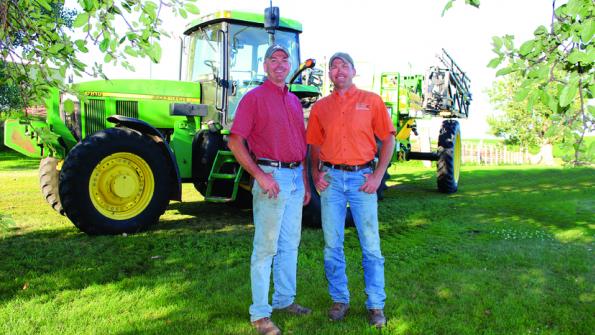
The story of the 2013 growing season has been different for every farmer. These three farmers all seem to have one thing in common, though. They each are progressive in their own ways. Read on about one farmer who plans to try cover crops for the first time next year; one that took the dive and traded in for a brand new Kinze planter; and one who had an eye-opening experience by adapting autosteer technology.
Like what you’re reading? Subscribe to Farm Industry News Now e-newsletter to get the latest news and more straight to your inbox twice weekly.
Jack and Gary Appleby
Brothers Jack and Gary Appleby, longtime members of the Team FIN group of farmers, seem to be on top of their game this year when it comes to their equipment. Farm Industry News interviewed Jack for this story, who said they had already placed an order this spring for the brand new Kinze 4900 24-row planter with electric drive that he saw at the 2013 National Farm Machinery Show in Louisville, Ky.
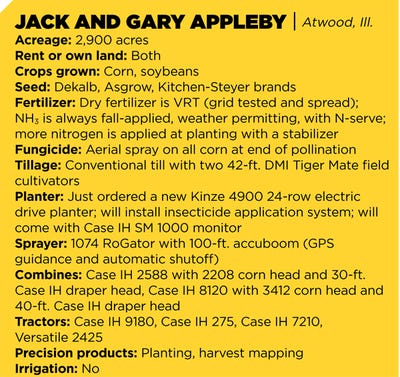 “We had been keeping tabs on what Kinze had been doing. We’re getting along fine with the planter we have from Kinze but it seems like everybody’s trying to improve something, and then we heard of the electric drive,” said Appleby. “And I think the electric drive portion is even American made.”
“We had been keeping tabs on what Kinze had been doing. We’re getting along fine with the planter we have from Kinze but it seems like everybody’s trying to improve something, and then we heard of the electric drive,” said Appleby. “And I think the electric drive portion is even American made.”
Appleby plans on setting up the new planter once it arrives for spring 2014 planting to be able to apply insecticide on all his corn acres. Recent corn rootworm pressure has pushed him toward a blanket insecticide application.
“Hopefully we’re a step ahead of the game by doing this. Studies are showing that you can gain another two or three bushels an acre by going ahead and just using insecticides on everything and being done with it,” he said.
Another piece of equipment they just traded in for this last winter was the RoGator sprayer with GPS guidance and automatic shut-off. Appleby says the cost savings will be significant over time due to the elimination of waste when the sprayer shuts off precisely at the end of a row.
LOOKING AHEAD
When asked about other technologies he uses on his farm, Appleby says he’s been hesitant about adopting variable-rate planting.
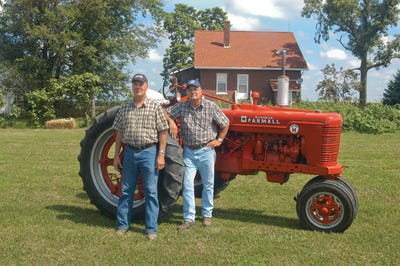
Jack and Gary Appleby have a brand new Kinze 4900 electric drive planter on the way for the 2014 growing season.
“I guess it’s getting pretty popular. We have some variance in very few fields where it might help. We’re so flat here in Illinois -- it’s not what I would call a lot of variance,” he said. “Some places where it rolls a little bit you might have clay hills where there’s no need to plant a high rate of corn because it’s just not going to pan out. I can see it [variable rate] coming down the road; probably using it to a prescription.” But Appleby noted he would need to be shown that the investment will pay off in order for him to invest in variable rate planting.
This year, it was late April before the Appleby brothers really started to plant their corn, and it was well past May 10 when they were finished. Regardless of late planting, Appleby remained optimistic about yields.
“Anytime in this area, the 10th or 15th of May is when you start losing your yield on corn. The corn sure looks good at this point because we’ve had so much rain. Things are looking good. I think we’ll be a little bit above average [on yields],” he said.
While he can’t predict what the weather will do, he’s also optimistic about his soybean yields. “As long as we keep the showers coming I think beans will be above average, too,” he said.
However, Appleby did have to re-spray a couple of his soybean fields.
“We’re at the point where nothing is sprayed with just Roundup anymore. You have got to tank mix it with something else,” he said. “There’s too much resistance to Roundup out there now. We’ve been doing a lot of fall burndown. This fall, weather permitting, we will spray 100% for fall burndown; that’ll help get rid of winter annuals.
10 or 15, maybe 20 years ago we were saving a lot of money because we got to use Roundup. It was a cheap fix but now, boy, the price is really creeping up since you’ve got to tank mix and do a lot of other things.”
One more way Appleby plans to increase his efficiency is during harvest this fall. He hopes to harvest all the corn with just one machine.
“That way it frees Gary or I up to drive a truck also instead of getting some part time labor,” he said. “It just saves us a little bit of money here and there.”
Jerry Fine
Southwest Iowa farmer Jerry Fine seemed confident in late July that his corn yields would turn out just fine this year as long as the weather cooperates for him through harvest.
“Right now, we have had only about an inch and a quarter of rain here in the last several weeks. We have had a break in the heat, which has helped us a lot,” said Fine. “We have a real potential, but if we don’t get any more rain before too long, it’s going to hurt our crop substantially. But right now, we’re looking at a fairly decent crop.”
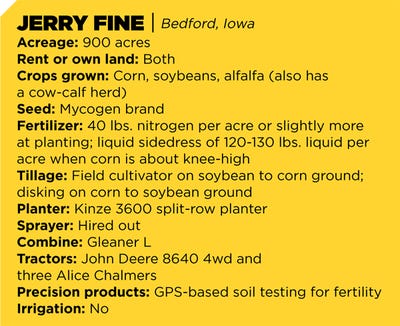 Fine said that if any further stress could be avoided for his corn crop this year, he predicted a potential of 130 to 150 bushel corn from his fields. Compared to last year’s drought-stricken corn crop, he says that will be a major improvement.
Fine said that if any further stress could be avoided for his corn crop this year, he predicted a potential of 130 to 150 bushel corn from his fields. Compared to last year’s drought-stricken corn crop, he says that will be a major improvement.
Fine’s biggest challenge this spring, like many others around the Midwest, was dealing with the very wet weather.
“It caused our corn not to root down, and then all of a sudden it turned cool early, and we had a little trouble with stand in our beans,” said Fine.
Others in his area have had to make some crucial adjustments because of late planting this year.
“I’ve heard from some of the guys around here that they’re going to 105-day corn and they’re looking at maybe 140 bushel if we don’t get a return of the heat and we get a little bit more moisture,” he said.
When asked about how he thinks his soybeans will turn out, Fine seemed a bit uneasy. “Our beans are kind of later out here and an early frost is not going to be anything we’re going to look forward to,” he said. “This year really makes a person nervous.”
Looking ahead to harvest time, he still has some decisions to make about the equipment he’ll use.
“I’ve got an L [Gleaner] that I’ve had for several years. I just keep working on it and repairing it and it’s been reliable but I’m at the point where I’m not sure what I’m going to do for this upcoming fall,” he said.
John Deere and AGCO brands seem to be his top two choices if he were to consider making the move, but he wouldn’t buy new.
“There are some combines out there that are just a couple of years old that I think would be good enough for me to get by,” said Fine. “Probably like a lot of others, I’m just waiting to see what this crop’s going to do before I jump over the edge.”
LOOKING AHEAD
Looking even further down the road to 2014, Fine has big plans to try something new for the next growing season.
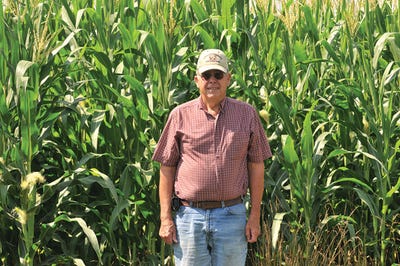
Jerry Fine is looking at good yields this year as long as the weather cooperates through the rest of the growing season. He plans to try out cover crops for the first time in 2014.
“I’m pretty sure that I’m going to go with some cover crops next year. I have not done that yet, and there’s a lot of interest in it,” he said. “I think I’m probably going to use some for a cover crop on ground that I farm, and I’m probably going to use some of the cover crops for utilization for livestock where I’ll bale it and use it as hay.” Fine also has considered a late fall or early spring grazing program with the cover crops.
Fine developed an interest in cover crops through several test plots in his area where they are mixing radishes and turnips.
“The exact mixture I’ll go with -- I don’t know -- but I’d almost bet that I’d go with radishes and rye for sure,” he said.
Some concerns he has about cover crops revolve around their effect on the many terraces in the land in southwest Iowa.
“Am I going to have to kill the rye off the terraces? And just how much nitrogen are we actually going to get from the radishes?” he asks. “There’s a lot of questions to be answered yet.”
Peter and Jay Bakken
To say that brothers Peter and Jay Bakken are busy is an understatement. Peter spoke with Farm Industry News in late July just as he was getting back from an agricultural trip to Colombia with the United Soybean Board. And he also mentioned his brother Jay is on the Minnesota Beef Council.
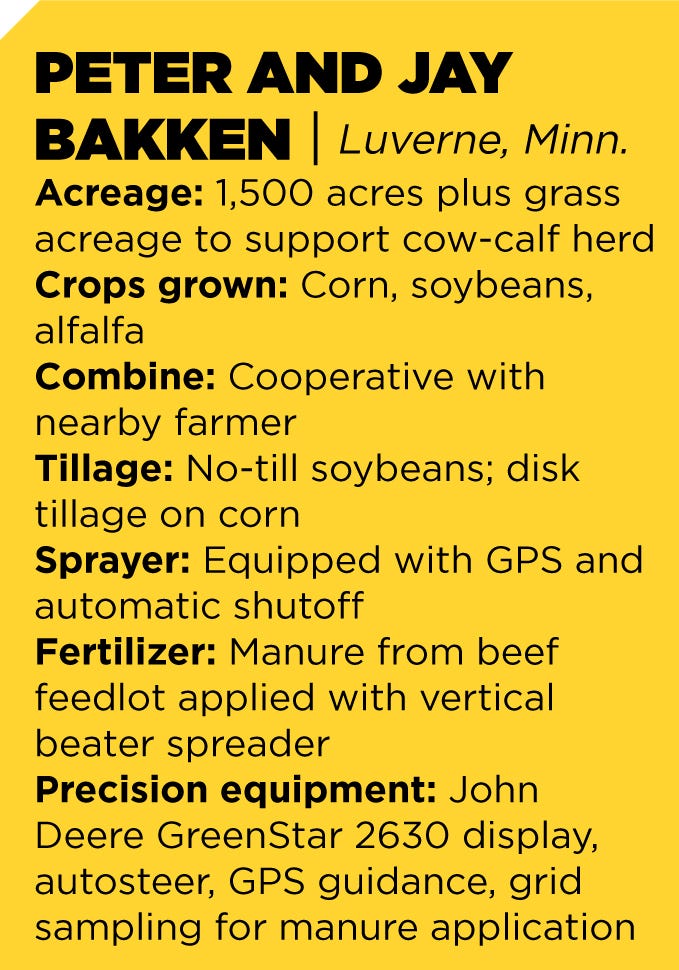 “As we have more things to deal with, and we’ve got more and more people that don’t understand agriculture, it becomes important to have farmer leaders in a capacity that they can get the factual information out there,” said Bakken.
“As we have more things to deal with, and we’ve got more and more people that don’t understand agriculture, it becomes important to have farmer leaders in a capacity that they can get the factual information out there,” said Bakken.
The trip made an impact on Bakken because of the perspective he gained on how seed from the U.S. and other countries is important in supporting farmers in smaller communities like the ones he saw in Colombia.
The Bakkens have a diversified operation, where everything they grow except for soybeans is fed through their beef feed lot and a beef cow-calf operation. And they seem optimistic about this year’s corn and soybean crop despite late planting.
“In our operation, we put up a lot of high-moisture corn, so in that respect, we do fairly well in dealing with years that we have wet corn. This year, planting was late. It just seemed like winter would never end,’ said Bakken.
Aside from his frustration with late planting, Bakken was excited to talk about a new technology he adopted in his tractor for planting.
“In the middle of corn planting this year, we got autosteer in the planting tractor. From the outside looking in and not having it, I thought ‘Why in the world can’t you steer straight enough to plant?’ But all it takes is one or two extra rows in a field for a few years and you’ve got the thing paid for,” he said. “As far as hours in a day and the efficiency with which you have to work, it was really an eye opener for me.”
Bakken said the biggest challenge he faced this year was dealing with his livestock.
“Calving was just a nightmare, but we got through that and we got planted. We do quite a bit of corn on corn here and so far, my corn on corn this year actually is probably the better looking crop that I’ve had,” he said.
For his alfalfa crop, Bakken tells a different story.
“We lost probably 70% of our alfalfa due to winterkill. So that’s going to be a challenge for us this year as far as coming up with the forage,” he said. One alternative he has switched to recently is grinding baled corn stalks for feed, which he will likely rely upon this fall.
Another big change for Bakken this year was in refining his fertility management.
“One thing that we did do this year that wasn’t terribly expensive was we went to a vertical beater spreader, and basically it reduced your particle sizes,” he said. Bakken noted that the switch from a horizontal to vertical beater, he was able to cover more ground with the right amount of nutrients in just one pass.
When harvest time comes around, Bakken will use a neighbor’s combine through a cooperative program he’s been involved with for over 25 years.
“We don’t have to own a combine, and he trades the combine in every couple years, so we’ve got the latest technology in the combine,” said Bakken. “Especially when you consider what a new combine costs and the acres you need to get over, it’s one of those things that works out well for both parties.“
LOOKING AHEAD
Looking down the road at investments he might make in new technology, Bakken mentions row control as a possible next step.

Brothers Peter and Jay Bakken found major benefits in implementing autosteer technology this planting season.
“With our contour farming, you come into point rows. My planter just has a manual half width disconnect, and one year that wasn’t working and boy, you want to see a yield hit and overplanting is awful,” said Bakken. “So that [row control] really has some value to me. You can physically see what the payback is on that by sheer yield.”
Bakken says he’s also been tinkering a little bit with sidedressing his corn on corn, but the verdict is still out on that. He may consider adjustments to his planter in the future, though.
“If I were to do anything with my corn planter, I would probably put starter fertilizer on it. I like the way that corn looks when it’s got starter fertilizer on it coming out of the ground,” he said.
About the Author(s)
You May Also Like






